Caper bushes (Capparis spp.) are some of the most common plants that you will come across when wandering through the wadis of South Sinai. They are also one of my favorites and one of my most photographed. So, I have a lot to say about them and too many photos. You’ve been forewarned. 😉
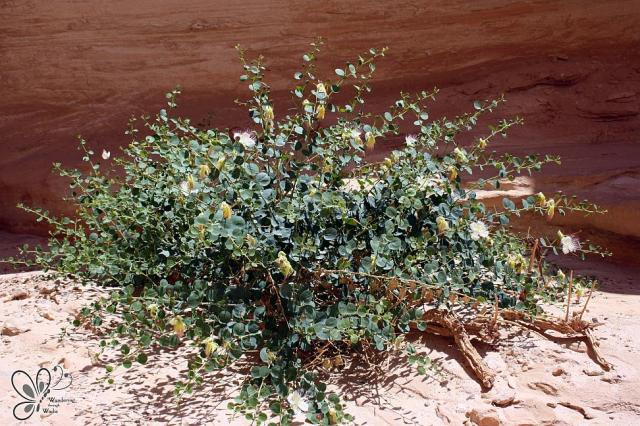
There are three species of capers growing in Sinai: Capparis decidua, C. sinaica, and two different subspecies of C. spinosa. C. decidua, which I have never seen, is easily distinguished from the other Capparis species. It grows as a small tree and the others are bushes. In English, we call them all capers, but the Bedouin differentiate between them. In Arabic, C. spinosa is called lasoof and C.sinaica is called lasaf.

Caper bushes are shrubs growing between 1 and 2.5 meters high. They usually grow prostrate along the ground, scrambling over rocks, or hanging in cliffs. Capers can tolerate saline soil and drought. And they love dry heat and direct sunlight! (This makes them excellent additions to desert gardens. More on that later.)

The branches are smooth and hairless and grow out from the base of the plant. The leaves are thick and fleshy and those of C. spinosa are round or oval while the leaves of C. sinaica are shaped more like an egg, getting narrower near the tip. The flowers – oh, the flowers! – are white with lots of stamen. In C. sinaica, these stamens are initially white but turn purple as they begin to wilt. In C. spinosa, they are white and pinkish-purple from the start and turn a darker purple. Both blooms are simply stunning!

Flower buds grow only on first-year branches, bloom at night, and live only for 24 hours. It is amazing to watch the blooms open, and since I have a caper bush in my own garden, I’ve had plenty of opportunities to do so.

I am seriously in love with these flowers and how their color changes throughout the day!


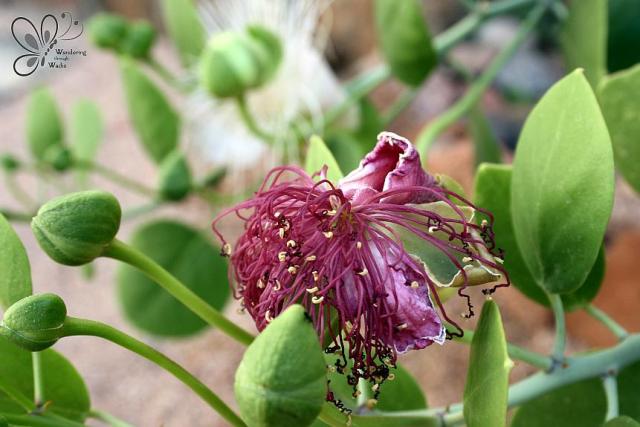
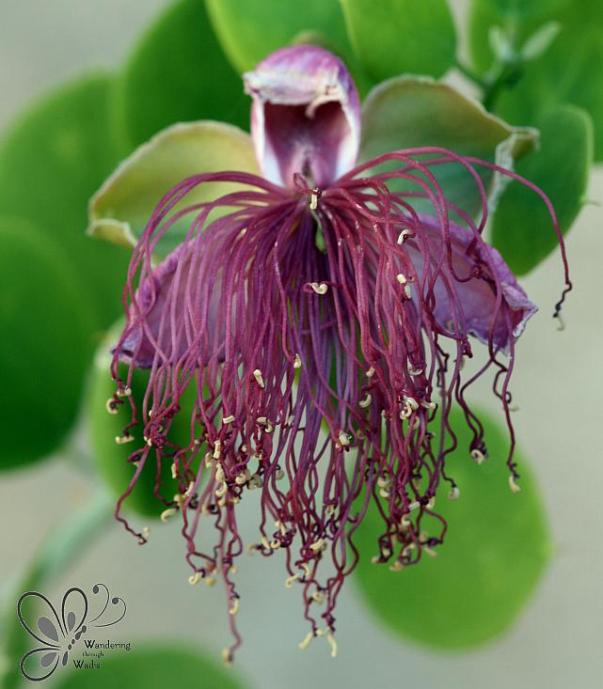
The fruits of these caper bushes are pretty amazing as well. They are somewhat pear-shaped; the young fruit are green, turning a brilliant red when ripe, and contain hundreds of small seeds. And they’re edible! (More on that later, too.)
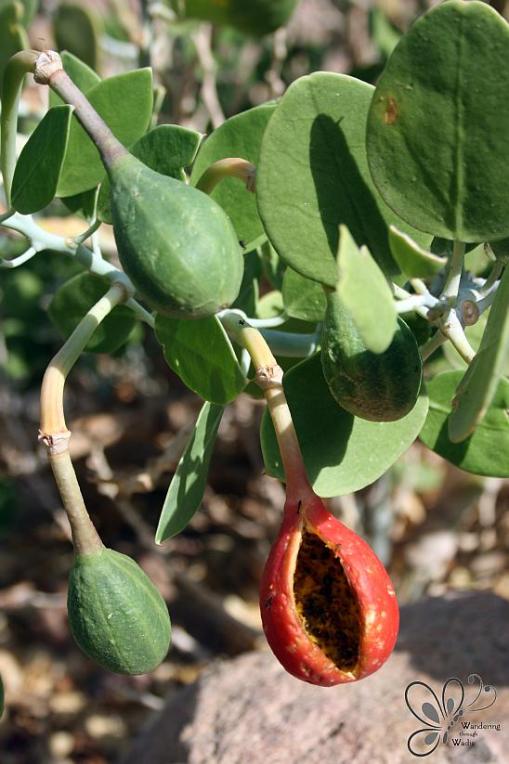
Caper bushes often have buds, flowers, and fruit at the same time. They start blooming in May and will continue to do so until late summer. When you come across these bushes in the wadis, you’ll often find the ants or other critters have already munched the seeds of the burst fruit.

But if you have a caper bush in your own garden, you can beat the ants to the feast!
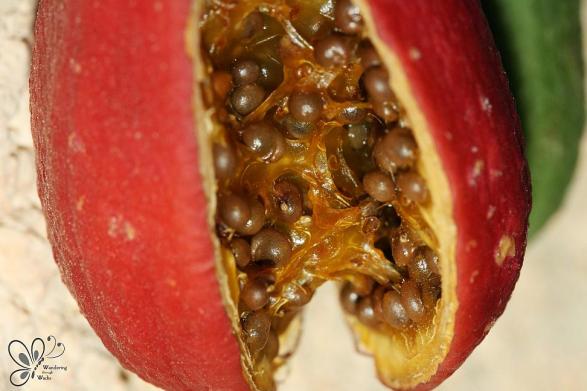
When we bought our land in Dahab nine years ago, we built our house and had an empty desert plot in front, a blank canvas, our garden. We planned on growing only local desert plants, and, for the most part, our little garden is made up of the same bushes and herbs you find growing in the desert wadis of South Sinai. Our plan definitely included a caper bush. I wanted one right underneath the front window.
Irena Springuel recommends capers in her book The Desert Garden: A Practical Guide because of their beautiful blooms and edible parts. She does warn, however, of the thorns and recommends keeping that in mind when choosing a planting site. You wouldn’t want visitors or children getting hurt by the spines. (And they do catch you! My husband and I have both been hooked on numerous occasions and it hurts.)
The notes that Springuel gives about propagating capers (C. spinosa) made me think it would be a challenge to grow a caper bush from seed. But I collected a ripe fruit from a bush (C. sinaica) in a nearby wadi and simply planted the seeds in a clay pot at home. Several sprouts grew and they continue to thrive in my garden today. We have a beautiful large bush now, exactly where I dreamed of having one, and it is producing loads of fruit. You can also propagate capers by cuttings, which we have done successfully, too.
If you’re looking for a beautiful, low-maintenance plant for your garden, try a caper bush! Many of the bushes around Dahab are fruiting right now, so it’s the perfect time to see them and collect seeds. In my next post, Caper Bush ~ Part II, I’ll tell you all about which parts of the plant you can eat, how to process and prepare them, and how the Bedouin use capers medicinally.
References:
Springuel, Irina. (2006). The Desert Garden: A Practical Guide. Cairo: The American University in Cairo Press.
And my book, too.

what a beautiful gallery of capers. I really enjoyed all your wonderful photos and specially like photos of decaying flowers. I have seen them in Greece, too. But unfortunately they don’t grow here in Northern Germany, it’s too cold.
LikeLike
Thank you! I’m happy you liked the photos. They are such beautiful flowers to photograph! But I imagine you get plenty of other gorgeous blooms in Germany. 🙂
LikeLiked by 1 person
that’s true. And by the way, I have been in the Sinai in the 70ies when I worked in a kibbuz. 🙂
LikeLike
Wow – what a great time to have been in Sinai! Or at least that what’s I hear. My first time here was 1999 – and it’s changed SO much since then…
LikeLiked by 1 person
When I was there in 1972 it still belonged to Israel and I went down up to Sharm-el-Sheikh. It was very natural then. Thanks for commenting, have a nice day, regards Mitza
LikeLike
Thanks! You, too. 🙂
LikeLiked by 1 person
Pingback: Large Salmon Arab Butterfly – Wandering through Wadis
Pingback: Green Lynx Spider – Wandering through Wadis
Pingback: Caper Bush – Part II – Wandering through Wadis
Pingback: Flora in Sinai: Pink ~ Purple Blooms – Wandering through Wadis
Pingback: Desert Plant Adaptations (IV) ~ Leaf Adaptations – Wandering through Wadis
Thank you so much for the wonderful information and photographs. I will never be casual about adding capers again.
LikeLiked by 1 person
Great blog Bernadette! In a recent long-distance hike across the desert, I learned that the bedouins call the caper bush ‘lasaf’. They collect the non-riped fruits and soak them in milk for ~1 week. The result is sort of a fermented drink with a taste similar to horseradish. It can be drunk or eaten with bread.
LikeLike
That’s right. The Bedouin name for one of the species (Capparis sinaica) is ‘lasaf’. Another species (Capparis spinosa) is called ‘lasoof’. Both are used as food and medicine by the Bedouin, but I’ve never heard of the soaking in milk. You mean goat milk, right? Sounds yummy!
LikeLike